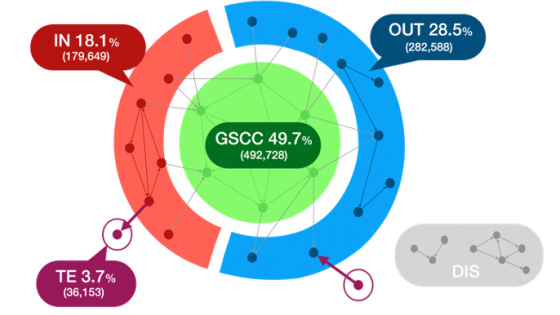The canonical input-output model (Leontief 1936) reveals how different industry sectors are interdependent and has been applied in the estimation of ripple effects caused by new demand. Today, the World Input-Output Database provides such a model covering 43 countries in the period 2000–2014.1 However, many recent researchers (Aoyama et al. 2010, Fujiwara and Aoyama 2010, Mizuno et al. 2014, Aoyama et al. 2017, Chakraborty et al. 2018, Inoue and Todo 2019, Fujita et al. 2019, Kichikawa et al. 2019) have begun to investigate the Japanese supply chain networks at the firm level.
The supply chain network is comprised of many connected components of different sizes. We focus on the largest connected component and call it the giant weakly connected component (GWCC). On the other hand, we call the components disconnected from the GWCC the disconnected components (DIS). Panel A of Figure 1 shows the walnut structure of the GWCC in the Japanese supply chain network in 2011. GWCC includes the giant strongly connected component (GSCC), the in component (IN), the out component (OUT), and the tendril components (TE). GSCC consists of firms such that for each pair of firms (X,Y) there is a directed path from firm X to firm Y and vice versa. IN consists of firms that can reach firms in GSCC but cannot be reached by firms in GSCC. OUT contains firms that can be reached by the firms in GSCC but cannot reach firms in GSCC. TE contains firms which have no access to GSCC and are not reachable from GSCC. Panel A of Figure 1 shows that GSCC is intricately interconnected and surrounded by its upstream and downstream (IN and OUT) components constituting two half-shells (Chakraborty et al. 2018). Panel B of Figure 1 shows the Japanese supply chain network at firm level in 2011 (Fujita et al. 2019). Each dot corresponds to each firm and is coloured by industry sector. The change in colours from warm to cold corresponds to the list of the industries from agriculture to service in the Japanese industry classification.
Figure 1 Japanese supply chain structure in 2011
a) The walnut structure of the GWCC
b) Japanese supply chain network at the firm level
Walnut structure, economic maturity, and economic complexity
The walnut structure of the supply chain network indicates the maturity of the economy. For example, in a closed and undeveloped country drawing from only the primary sector of the economy, the supply chain network is the bipartite network in which customers directly connect to producers of agricultural products. However, if some persons in that country begin to make processed food and materials, the said persons will buy agricultural products from the producers and sell processed material to customers. If the said persons consider increasing their productivity, they would introduce machines. This will prompt some other person in the country to begin making machines. Therefore, GSCC emerges in the supply chain network, and the pursuit of efficiency and innovation makes GSCC gigantic and complex. The Atlas of Economic Complexity2 reveals that the economic complexity in Japan has been the highest in the world from 1995 to the present. Figure 2 shows the TreeMaps of exports in 2018 by Japan and Nigeria, respectively. The TreeMap displays the breakdown of exports of each country by product. Countries with the lowest economic complexity change year by year. Nigeria had the lowest economic complexity in 2018. By comparing these two panels, we can imagine that unlike the Japanese supply chain network, the Nigerian one does not have a walnut structure.
Figure 2 The TreeMap of Japanese exports (left) and Nigerian exports (right) in 2018
Source: The Atlas of Economic Complexity
Dynamics of the Japanese supply chain network
The maturity of the economy allows us to imagine a stable supply chain network. To confirm the validity of this hypothesis, we investigate the change in the walnut structure from 2011 to 2016. Panel A of Figure 3 shows a matrix in which each element is derived from the ratio of the number of firms in 2011 and 2016. The numbers shown in the upper part of the matrix corresponds to the number of firms in 2011. This panel shows that 79% of firms in GSCC, 57% of firms in IN, and 59% of firms in OUT stayed within the same component groups. On the other hand, this panel shows that 16% (15%) of firms in IN (OUT) moved to GSCC and that 2.9% (3.4%) of firms in GSCC moved to IN (OUT). In addition, 35%, 25%, and 32% of firms in DIS move to IN, GSCC, and OUT, respectively, and 24% of firms in IN, 15% of firms in GSCC, and 23% of firms in OUT left GWCC. Therefore, the Japanese supply chain network is in fact not stable, contrary to the popular image of the maturity of the economy. Panel B of Figure 3 shows the change in the Japanese supply chain network at the firm level from 2011 to 2016 (Fujita et al. 2019). In this figure, the difference between 2011 and 2016 is shown in bright colours. Similar to the Panel B of Figure 1, colours distinguish the industry sector. We can see that GSCC is more stable than IN and OUT.
Figure 3 Dynamics of the Japanese supply chain structure
a) Transitions in the walnut structure, 2011-2016
b) Change in supply chain structure at firm level, 2011-2016
Notes: Panel A shows the transitions in the walnut structure from 2011 to 2016. Panel B shows the change in the Japanese supply chain network at firm level from 2011 to 2016.
Intra-component sales and growth
Firms that stayed within the same components are expected to be the backbone of the Japanese economy. For these firms, we investigate the distribution of sales and the distribution of the growth rate of firm sales from 2014 to 2016 as an example. Panel A of Figure 4 depicts a log-log plot of the complementary cumulative distribution function (CCDF) of firm sales. Here, the CCDF is almost the same as the rank-size plot. This panel suggests that the component with the largest number of big firms is GSCC. OUT also contains a large number of big firms. Note that the size of firms in IN and TE are almost identical in the Panel A of Figure 4. In contrast, Panel B of Figure 4 depicts the log-log plot of the probability density function (PDF) of the conditional growth rate of firm sales from ¥108 to ¥108.5. This figure shows that distributions of growth rate for each component are almost the same except for the left tail portion of the graph. In the left tail portion, the probability density is the smallest in GSCC, which means that firms contained in GSCC tend not to make large losses.
Figure 4 Distribution functions of firm sales
a) Complementary cumulative density of firm sales in the intra-components in 2016
b) Conditional probability density of sales growth in the intra-components, 2014-2016
Notes: Panel A shows the log-log plot of the CCD of sales of firms in the intra-components in 2016. Panel B shows the log-log plot of the conditional probability density of the growth rate of sales of firms in the intra-components from 2014 to 2016.
Inter-component growth rate of firms
It is natural to consider that the most drastically growing or declining firms constitute the transition part from IN (OUT) to GSCC and from GSCC to IN (OUT). Thus, we investigate the distribution of the growth rate of firm sales from 2014 to 2016 as an example. Panel A of Figure 5 depicts the log-log plot of the PDF of the growth rate of the sales of firms that constitute the transition from IN to GSCC (IN-GSCC; dark red) and that from GSCC to IN (GSCC-IN; dark green). In this figure, the light red line (IN) and the light green line (GSCC) are reference lines and the same as the red line and the green line in Panel B of Figure 4, respectively. By comparing these four lines, we observe that the right tail of IN-GSCC is fatter than the other three distributions. This means that the firms contained in IN-GSCC tend to have a positive and high growth rate. On the other hand, the left tail of GSCC-IN is fatter than the other three distributions. This means that the firms contained in GSCC-IN tend to have a negative and low growth rate. Panel B of Figure 5 depicts the log-log plot of the PDF of the growth rate of the sales of firms that constitute the transition from OUT to GSCC (OUT-GSCC; dark blue) and that from GSCC to OUT (GSCC-OUT; dark green). The light blue line (OUT) and the light green line (GSCC) are the same as the blue line and the green line in Panel B of Figure 4, respectively. In terms of similarities to Panel A, we observe that the right tail of OUT-GSCC is fatter than the other three distributions. This means that the firms contained in OUT-GSCC tend to have a positive and high growth rate. On the other hand, the left tail of GSCC-OUT is fatter than the other three distributions. This means that the firms contained in GSCC-OUT tend to have a negative and low growth rate.
Figure 5 Probability density functions of the growth rate of firm sales
a) GSCC-IN and IN-GSCC
b) GSCC-OUT and OUT-GSCC
Notes: Panel A shows the log-log plot of the probability density function (PDF) of the growth rate of the sales of the firms that constitute the transition from the IN to GSCC and that from GSCC to IN. Panel B shows the log-log plot of the probability density function (PDF) of the growth rate of the sales of the firms that constitute the transition from OUT to GSCC and that from GSCC to OUT.
Conclusion
The Japanese supply chain network forms a walnut structure, which is characterised by the intricately interconnected GSCC surrounded by its upstream and downstream (IN and OUT) components constituting two half-shells. This walnut structure describes the maturity and complexity of the economy. Although the Japanese economy is highly mature, the supply chain network is in the midst of active change. Firms that move from IN or OUT to GSCC tend to have a high positive growth rate in sales. On the other hand, firms that move from GSCC to IN or OUT tend to have a low negative growth rate in sales. Therefore, to make the supply chain network resilient to pandemics and to sustain firm growth rates, we need to rewire the supply chain network and understand the walnut structure, including the intricately interconnected GSCC.
References
Aoyama, H, Y Fujiwara, Y Ikeda, H Iyetomi and W Souma (2010), Econophysics and companies: statistical life and death in complex business networks, Cambridge University Press.
Aoyama, H, Y Fujiwara, Y Ikeda, H Iyetomi, W Souma and H Yoshikawa (2017), Macro-econophysics: new studies on economic networks and synchronization, Cambridge University Press.
Chakraborty, A, Y Kichikawa, T Iino, H Iyetomi, H Inoue, Y Fujiwara and H Aoyama (2018), "Hierarchical communities in the walnut structure of the Japanese production network", PLoS ONE 13(8): e0202739.
Fujita, Y, W Souma and Y Fujiwara (2019), "Macroscopic features of production network and sequential graph drawing", Evolutionary and Institutional Economics Review 16(1): 183-199.
Fujiwara, Y and H Aoyama (2010), "Large-scale structure of a nation-wide production network", The European Physical Journal B 77(4): 565-580.
Inoue, H and Y Todo (2019), "Firm-level propagation of shocks through supply-chain networks", Nature Sustainability 2(9): 841-847.
Kichikawa, Y, H Iyetomi, T Iino and H Inoue (2019), "Community structure based on circular flow in a large-scale transaction network", Applied Network Science 4(1): 92.
Leontief, W W (1936), "Quantitative input and output relations in the economic systems of the United States", The review of economic statistics 18(3): 105-125.
Mizuno, T, W Souma and T Watanabe (2014), "The structure and evolution of buyer-supplier networks", PLoS ONE 9(7): e100712(10).
Endnotes
1 WIOD, http://www.wiod.org/home.
2 The Atlas of Economic Complexity, https://atlas.cid.harvard.edu







